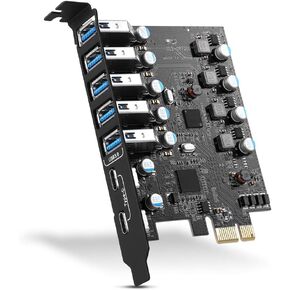- Shopping, made easy.
- /
- Get the app!
【Not equipped with Low-profile bracket. The USB 3.2/3.1 PCIe card has an overall length of 4.76(in)and a USB-A ports height of 0.71(in),It doesn't apply to small computers and server chassis, such as 1U and 2U.We weighed capacity and convenience, so we designed the USB port on the card to be vertically oriented. For the issue of being unable to insert the USB device, first insert the USB flash drive/USB cable into the USB slot for positioning.(For the narrow rear slot area of the PC host, you need to just cut the crossbar between the 2 slots with small sheet metal hand pliers.)】
Product Advantages:
1.Add 4 USB A/4 Type USB C ports on the desktop computer through the PCIe slot,Transmit data transfer speeds of up to 10 Gbit/s.
2. The USB port draws power directly from the PCI Express slot. Unlike some other devices,the PCIe USB 3.2/3.1 Gen 2 card doesn't require any additional power cables to be connected from the power supply, reducing cable clutter inside the host computer.
3.The internal USB card passes from the motherboard through the PCI Express slot - ensuring a stable connection and increasing data transfer speed. No loss of connection issues like an external USB hub.
Supported Operating Systems:
For Windows XP, Vista, 7, 8, 8.1, 10(32/64bit), Windows Server 2003, 2003R2, 2008, 2008R2, 2012, 2012R2, 2016, 2019(32/64bit) (Dell motherboard win10 and Win11 system, there may be compatibility problems, please carefully order)
For Mac Pro 4.1,5.1,7.1(model 2010~2020).
For Linux.(Mint, ocky Linux 9.3, Linux kernel 6.6, Ubuntu 20.04, etc.)
Note:
1. Don't install this PCIe USB card when the computer is turned on.
2. Thisonly supports data transmission, not video signal transmission (DP, Fast charging,HDMI, Thunderbolt protocol ,monitor), you must pay attention before choosing.
3. USB A port power supply: 5V-0.9A;USB-C port power supply: 5V-3A, USB 3.2/3.1 card only suitable for low-power USB devices.
4. The PCIe USB Card belongs to USB 3.2 Gen 2x1, also known as USB 3.1 Gen 2, with a speed of bandwidth 10Gbps according to the USB standard.
 YEELIYA PCIe Expansion Card to 5-Port (3X USB C,2X USB 3.0-A) PCI Express Expansion Card PC Internal USB 3.0 Port Cards for Windows 10/8/7 and MAC OS 10.8.2 Above
KWD 9.500
YEELIYA PCIe Expansion Card to 5-Port (3X USB C,2X USB 3.0-A) PCI Express Expansion Card PC Internal USB 3.0 Port Cards for Windows 10/8/7 and MAC OS 10.8.2 Above
KWD 9.500
 -23%
PCI-E to USB 3.0 7-Port(2X USB-C - 5X USB-A) Expansion Card,PCI Express USB Add in Card, Internal USB3 Hub Converter for Desktop PC Host Card Support Windows 10/8/7/XP and MAC OS 10.8.2 Above
KWD 15
-23%
PCI-E to USB 3.0 7-Port(2X USB-C - 5X USB-A) Expansion Card,PCI Express USB Add in Card, Internal USB3 Hub Converter for Desktop PC Host Card Support Windows 10/8/7/XP and MAC OS 10.8.2 Above
KWD 15
 6 Ports USB PCIE Card (2X Type-E Adapter,2X USB 3.0-C, 2X USB A) PCI Express USB Cards PC Front Panel Header for Windows 7/8/10 Linux and MacPro 4.1/5.1
KWD 11
6 Ports USB PCIE Card (2X Type-E Adapter,2X USB 3.0-C, 2X USB A) PCI Express USB Cards PC Front Panel Header for Windows 7/8/10 Linux and MacPro 4.1/5.1
KWD 11
 -6%
PCIe to USB 3.2 Gen 2 Adapter Card with 20 Gbps Bandwidth 5-Port (3X USB C -2X USB A) PCI Express Expansion Card Internal USB Hub PCI-E Add-on Cards Riser for Windows 10/8/7 and MAC OS 10.8.2 Above
KWD 15.500
-6%
PCIe to USB 3.2 Gen 2 Adapter Card with 20 Gbps Bandwidth 5-Port (3X USB C -2X USB A) PCI Express Expansion Card Internal USB Hub PCI-E Add-on Cards Riser for Windows 10/8/7 and MAC OS 10.8.2 Above
KWD 15.500